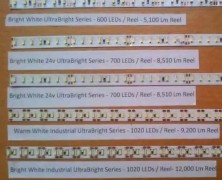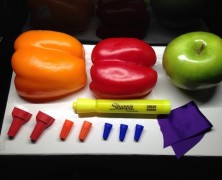Looking to increase your boat lighting’s functionality and/or “bling” factor? If so, you’re not alone — we here at Flexfire LEDs get calls all the time with questions about installing LED strip lights in boats and yachts. So many in fact, that we’ve decided to share a few ideas and address some of the more common issues with this sort of installation. Whether you’re running a skipper or a barge, taking your boat out for pleasure or for fishing, LED strip lights are a great solution for low energy lighting that can be fully customized to meet the individual size and lighting demands of your boat. The first thing to consider when looking into LED strip lights for your boat is to determine whether the lights will be exposed to environmental elements such as water or sand. If you’re considering LED strips for your deck lighting, or perhaps outside of the hull, make sure the lights are rated for outdoor use and water protection. Each of our LED strip lights has an IP rating that specifies the amount and type of protection it receives from the elements. IP ratings consist of two numbers — the first number refers to the amount of protection against solid objects, and the second refers to liquid protection. The numbers for solid object protection run from 0 (no protection) through 6 (full protection), while the numbers for liquid protection run 0 through 8. A fully waterproof LED strip light would thus have a rating of IP68. For deck accent lighting, we suggest our colorful, customizable and versatile IP65 Outdoor ColorBright™ LED strip lights, which come in static red, green and blue, as well as remote-controlled color changing RGB. Many people call us looking to generate the attractive indirect glow they’ve seen on other boats. To achieve this...
Understanding The Different Numbers Used In LED Strip Lights...
posted by Flexfire LEDs
When shopping for LED strip lights, you’ll regularly come across numbered terms such as 3020, 3528, and 5050. So what do these numbers mean, and why are they important in your buying process? This simple explanation will help you in understanding the different numbers used in LED strip lights. First, a basic understanding of how the strips themselves are constructed. The LED chips are mounted onto a thin, flexible metal strip that acts as a heat sink, drawing heat from the light chips and allowing them to remain cool during operation. This construction accounts for the “SMD” you’ll often see in strip light specifications, which stands for Surface Mount Device. The four-digit designation refers to the dimensions of the chip itself, in millimeters. A 3528 chip, for example, measures 3.5mm by 2.8mm, while a 5050 chip is 5.0mm by 5.0mm square. These different sizes dictate how many chips can be placed on a strip, which in turn determines its particular light qualities. Each has its benefits, so let’s break them down one at a time. The 5050 chips that Flexfire LEDs uses are actually composed of 3 light diodes, a construction sometimes referred to as a tri-chip. With 3 diodes, a 5050 chip will be brighter than other chips with one individual diode. But while a tri-chip is theoretically three times brighter, their larger size means fewer of them will fit onto a strip’s PCB (Printed Circuit Board). It also means they will generate more heat, requiring a thicker PCB to act as a heat sink. Finally, a tri-chip can be constructed with different types of diodes in the same chip, generating unique visual results. The three diodes can be combined to create millions of different color combinations, making them an excellent choice for...
Flexfire LEDs Spring 2014 Photo Contest...
posted by Flexfire LEDs
We take pride in helping customers complete all sorts of LED lighting installations. From restaurants and hotels to basic kitchen redesigns, each project has a unique story. For this reason, we are always eager to see photographs of completed projects using Flexfire LEDs strip lights. To this end, we encourage you to participate in the Flexfire LEDs Spring 2014 Photo Contest. Every Entry Wins! We now have two separate contests, and everyone who submits a qualifying entry will win! Our standard photo contest awards prizes in each of three categories, while our new “Step-by-Step Tutorial” contest rewards those who share thorough details of their projects. Furthermore, everyone who sends us a qualifying submission for either contest will receive a coupon for $30 off any reel of Flexfire LEDs strip lights. Below you’ll find details for each of our two contests. Contest 1: Photo Contest Send us a high-resolution photograph of your completed project using Flexfire LEDs products and we’ll reward you with a coupon for $30 off any reel of Flexfire LEDs strip lights. One winner will be selected in each of these three categories: 1. Best Residential Installation (kitchens, bedrooms, bathrooms, basically anywhere in your home) 2. Best Commercial Installation (retail stores, bars/restaurants, offices, signage, etc.) 3. Best Hobby/Creative Installation (past examples include terrariums, Halloween costumes, and a flying wingsuit!) The winning project in each category will receive a FREE reel of Flexfire LEDs ColorBright strip lights. Again, please be sure to send us a high-resolution photograph, as blurred, low-quality images will not be considered. Contest 2: Step-by-Step Tutorial Contest Many of our customers see these great project photos and wonder, “How did they do that?” We’d love to share your step-by-step installation story on our blog. Everyone who submits a qualifying “Step-By-Step Tutorial” entry will receive a...
Why You Should Care About CRI...
posted by Flexfire LEDs
CRI, or Color Rendering Index, is the latest buzzword in consumer lighting circles. With the current phasing out of traditional incandescent bulbs, many consumers are scrambling to understand their remaining choices. Savvy lighting manufacturers understand this, and have invested a great deal in educating customers about things like color temperature, lumens, and now CRI. So how does CRI work? Basically, take a light bulb and shine it onto a few bright, colorful items. How natural do their colors look? Color Rendering Index is a mathematical measure of this, where a light source is tested and given a score from 0-100. Any light bulb, tube, or strip that measures greater than 90 is typically considered “High CRI”, and thus very effective at rendering natural-looking color at a given color temperature. As a point of reference, many of the fluorescent or other types of lighting that people consider “harsh” or “artificial” measure in the 50-70 CRI range. Take a look at the two photos above. In the first photo, under lights rated at CRI 57, the orange bell pepper has lost much of its natural color, appearing almost yellow. Similarly, the green apple, red bell pepper, and yellow marker appear dull and lifeless. In the second photo, under CRI 93 lighting, the colors are much more alive in comparison, down to the white board on which everything is placed. Testing for CRI requires special machinery designed specifically for this purpose. During this test, a lamp is shone onto eight different colors (or “R values”), termed R1 through R8. The lamp receives a score from 0-100 for each color, based on how natural the color is rendered in comparison with how the color looks under a “perfect” or “reference” light source at the same color temperature...
Flexfire LEDs Announces High CRI LED Strip Lights...
posted by Flexfire LEDs
In keeping with its commitment to providing innovative LED lighting solutions, California-based Flexfire LEDs has announced its new UL Listed UltraBright™ High CRI Series LED Strip Lights. Designed to meet today’s higher lighting quality standards, this new line measures >93 on the color rendering index, fortifying the company’s reputation for delivering cutting edge technology at consumer-friendly prices. CRI, or color rendering index, is the standard measure of a luminaire’s ability to accurately render a specific color spectrum in comparison with a perfect reference source at a given color temperature (i.e. daylight). Simply put, if you direct the light onto a particular object, how natural do its colors look? Testing for CRI is a complicated process, requiring specialized machinery designed specifically for this purpose. Lamps are tested in terms of how they render eight basic colors (or “R values”), termed R1 through R8. A score from 0-100 is given for each color, and these eight numbers are then averaged to determine the lamp’s overall CRI rating. Those measuring above 90 are generally considered highly effective at rendering natural color; for a practical understanding, many of the traditional fluorescent lights that people consider “harsh” or “artificial” measure in the 60-70 CRI range. LED lighting is the established industry leader in energy efficiency, and advanced technological development means LED products are now available at dramatically lower prices than even just a few years ago. This dynamic is driving a worldwide shift to LED lighting, one that is further accelerated by government regulations such as those found in California’s Title 24. Established by the State’s Energy Commission, Title 24 addresses a number of energy efficiency standards, particularly those having to do with lighting. To be classified as “High Efficacy” and thus qualify for utility rebates and other advantages,...










